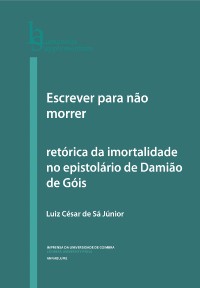Please use this identifier to cite or link to this item:
https://hdl.handle.net/10316.2/77326| DC Field | Value | Language |
|---|---|---|
| dc.contributor.author | Junior, Luiz César de Sá | por |
| dc.date.accessioned | 2018-10-20T17:07:15Z | |
| dc.date.accessioned | 2020-03-16T22:34:06Z | - |
| dc.date.available | 2018-10-20T17:07:15Z | |
| dc.date.available | 2020-03-16T22:34:06Z | - |
| dc.date.issued | 2018 | - |
| dc.identifier.isbn | 978-989-26-1529-5 | por |
| dc.identifier.isbn | 978-989-26-1530-1 (PDF) | por |
| dc.identifier.uri | https://hdl.handle.net/10316.2/77326 | por |
| dc.description.abstract | The book deals with the epistolary of Damião de Góis from the perspective of the rhetorical constitution of his public prestige and the representation of his auctoritas, evaluating the dimension of the social relations that he established from his stay in Flanders in the service of the crown until his return to Portugal, around two decades later (1525-1545). During this period, we investigate how he could have developed the technical aspects of his epistolary writing, as well as its uses in the interaction with important dignitaries and men of letters of his time. It is demonstrated that his public image varied according to the specific circumstances in which he acted. Representing himself as the obsequious interpreter of the overseas deeds of his kingdom, the persuasive diplomat ready to interfere in the literary and religious quarrels of the time, and as the expert capable of presenting himself as a scholar worthy of imitation and future emulation, Góis sought to intertwine the praise of the crown to the recognition of his own prestige, hoping thereby to tie his destiny to the immortality then providentially associated with the Portuguese kingdom. | eng |
| dc.description.abstract | O livro trata do epistolário de Damião de Góis a partir da constituição retórica de seu prestígio público e da representação de sua auctoritas, avaliando a dimensão das relações sociais por ele estabelecidas desde sua estadia na Flandres a serviço da coroa até seu retorno a Portugal, cerca de duas décadas mais tarde (1525-1545). Nesse período, investiga-se como pode ter desenvolvido os aspectos técnicos de sua escrita epistolar, assim como seu uso na interação com importantes dignitários e homens de letras de seu tempo. Demonstra-se que sua imagem pública foi formulada a partir de diferentes ethe compostos diante das necessidades específicas dos diferentes contextos em que atuou. Representando-se ora como o obsequioso intérprete das gestas ultramarinas de seu reino, ora como o persuasivo diplomata pronto a interferir nas querelas letradas e religiosas de então, e, ainda, como o especialista capaz de se apresentar como auctor digno de imitação e emulação futura, Góis procurou entrelaçar o louvor à coroa ao reconhecimento de seu próprio prestígio, esperando, com isso, atrelar seu destino à imortalidade então providencialmente associada ao reino português. | por |
| dc.format.extent | 260 p. | por |
| dc.language.iso | por | por |
| dc.publisher | Imprensa da Universidade de Coimbra | por |
| dc.rights | open access | por |
| dc.subject | Damião de Góis | eng |
| dc.subject | rhetoric of immortality | eng |
| dc.subject | auctoritas | eng |
| dc.subject | humanism | eng |
| dc.subject | Damião de Góis | por |
| dc.subject | retórica da imortalidade | por |
| dc.subject | auctoritas | por |
| dc.subject | humanismo | por |
| dc.title | Escrever para não morrer: retórica da imortalidade no epistolário de Damião Góis | por |
| dc.title.alternative | A path to immortality: the use of rhetorical devices in Damião de Góis’ epistles | eng |
| dc.type | book | por |
| uc.publication.location | Coimbra | por |
| dc.identifier.doi | 10.14195/978-989-26-1530-1 | por |
| uc.publication.digCollection | PB | por |
| uc.publication.area | Artes e Humanidades | por |
| uc.publication.manifest | https://dl.uc.pt/json/iiif/10316.2/77326/151617/manifest?manifest=/json/iiif/10316.2/77326/151617/manifest | - |
| uc.publication.thumbnail | https://dl.uc.pt/retrieve/8362122 | - |
| uc.itemId | 55067 | - |
| item.grantfulltext | open | - |
| item.fulltext | With Fulltext | - |
| Appears in Collections: | Pombalina | |
Files in This Item:
| File | Description | Size | Format | |
|---|---|---|---|---|
| escrever_para_n_o_morrer.pdf | 6.16 MB | Adobe PDF |  |
Items in DSpace are protected by copyright, with all rights reserved, unless otherwise indicated.
